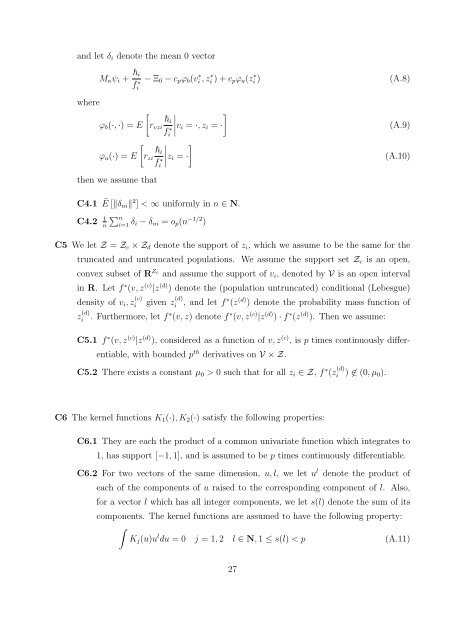weighted and two stage least squares estimation of ... - Boston College
weighted and two stage least squares estimation of ... - Boston College
weighted and two stage least squares estimation of ... - Boston College
You also want an ePaper? Increase the reach of your titles
YUMPU automatically turns print PDFs into web optimized ePapers that Google loves.
<strong>and</strong> let δi denote the mean 0 vector<br />
Mκψi + i<br />
f ∗ i<br />
where<br />
<br />
ϕb(·, ·) = E<br />
<br />
ϕa(·) = E<br />
− Ξ0 − cpϕb(v ∗ i , z ∗ i ) + cpϕa(z ∗ i ) (A.8)<br />
i<br />
rvzi<br />
f ∗ i<br />
i<br />
rzi<br />
f ∗ i<br />
then we assume that<br />
<br />
<br />
<br />
vi <br />
= ·, zi = ·<br />
<br />
<br />
<br />
zi <br />
= ·<br />
C4.1 ˜ E [δni 2 ] < ∞ uniformly in n ∈ N.<br />
C4.2 1<br />
n<br />
n<br />
i=1 δi − δni = op(n −1/2 )<br />
(A.9)<br />
(A.10)<br />
C5 We let Z = Zc × Zd denote the support <strong>of</strong> zi, which we assume to be the same for the<br />
truncated <strong>and</strong> untruncated populations. We assume the support set Zc is an open,<br />
convex subset <strong>of</strong> R Zc <strong>and</strong> assume the support <strong>of</strong> vi, denoted by V is an open interval<br />
in R. Let f ∗ (v, z (c) |z (d) ) denote the (population untruncated) conditional (Lebesgue)<br />
density <strong>of</strong> vi, z (c)<br />
i<br />
given z (d)<br />
i , <strong>and</strong> let f ∗ (z (d) ) denote the probability mass function <strong>of</strong><br />
z (d)<br />
i . Furthermore, let f ∗ (v, z) denote f ∗ (v, z (c) |z (d) ) · f ∗ (z (d) ). Then we assume:<br />
C5.1 f ∗ (v, z (c) |z (d) ), considered as a function <strong>of</strong> v, z (c) , is p times continuously differ-<br />
entiable, with bounded p th derivatives on V × Z.<br />
C5.2 There exists a constant µ0 > 0 such that for all zi ∈ Z, f ∗ (z (d)<br />
i ) ∈ (0, µ0).<br />
C6 The kernel functions K1(·), K2(·) satisfy the following properties:<br />
C6.1 They are each the product <strong>of</strong> a common univariate function which integrates to<br />
1, has support [−1, 1], <strong>and</strong> is assumed to be p times continuously differentiable.<br />
C6.2 For <strong>two</strong> vectors <strong>of</strong> the same dimension, u, l, we let u l denote the product <strong>of</strong><br />
each <strong>of</strong> the components <strong>of</strong> u raised to the corresponding component <strong>of</strong> l. Also,<br />
for a vector l which has all integer components, we let s(l) denote the sum <strong>of</strong> its<br />
components. The kernel functions are assumed to have the following property:<br />
<br />
Kj(u)u l du = 0 j = 1, 2 l ∈ N, 1 ≤ s(l) < p (A.11)<br />
27

















